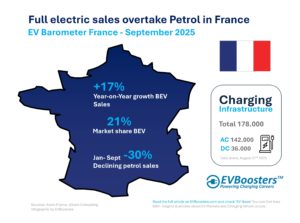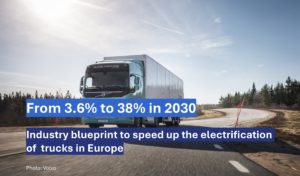EVs as “Virtual Power Plants”: A new role in Europe’s energy grid
As the report highlights, EVs have the potential to become a significant power source for the EU. By 2040, EVs equipped with bidirectional charging could supply up to 9% of Europe’s electricity demand, making them the continent’s fourth-largest power source. With enough EVs connected to the grid, they could feed power back to the system at critical times, supplying as much as 15–20% of peak electricity needs. This shift positions EVs as an enormous, distributed virtual power plant, reinforcing Europe’s energy resilience and supporting its shift to renewables.
The potential savings are equally impressive. Fraunhofer’s analysis shows that bidirectional charging could lower EU energy system costs by 5,5% by 2030, equating to €9,7 billion annually. By 2040, this figure could rise to €22,2 billion per year, resulting in cumulative savings of around €175 billion—close to the entire 2023 EU budget.
Making room for more renewables
Europe’s transition to renewable energy requires robust storage and flexibility, particularly for solar and wind power. Bidirectional EV charging could provide both. The report suggests that by allowing EVs to store excess renewable energy during off-peak hours, the EU could add an additional 430 gigawatts (GW) of solar power by 2040—almost twice its current capacity. When energy demand spikes, EVs could discharge stored energy back into the grid, reducing reliance on fossil fuel power plants and cutting emissions.
Moreover, bidirectional charging could drastically reduce the need for costly stationary battery storage systems. The study estimates that, by 2040, bidirectional EVs could decrease the need for stationary storage by as much as 92%. Similarly, backup power plant capacity could drop by 126 GW, cutting costs further and helping the EU achieve its carbon reduction goals without excessive infrastructure investments.
A win for both consumers and the grid
The economic benefits of bidirectional charging aren’t limited to national energy savings. For individual EV owners, this technology could offer substantial reductions in household electricity bills. According to the report, European EV drivers could save between 4% and 52% on their annual electricity costs, depending on factors like location, vehicle battery size, and whether they own solar panels. For some, this could mean annual savings between €31 and €780, with even greater potential earnings if they feed excess power back to the grid.
For Europe’s energy grid, bidirectional charging also offers relief. By reducing the strain on low-voltage grids, it could save an estimated €9,8 billion in grid expansion costs by 2040. However, the report cautions that bidirectional charging alone won’t eliminate the need for broader grid upgrades. Instead, it should be viewed as a supportive measure that enhances the grid’s flexibility and helps manage demand fluctuations in real-time.
Overcoming challenges: Infrastructure and interoperability
While the potential of bidirectional charging is enormous, Europe faces significant barriers to its widespread adoption. Currently, not all EVs are capable of bidirectional charging, and the necessary infrastructure, such as bidirectional charging stations, remains limited. Compounding this issue is the lack of standardised technology across Europe, with various manufacturers adopting either AC or DC charging standards, which could limit compatibility between EVs and chargers.
To address these challenges, the Fraunhofer report urges the EU to implement regulations that mandate bidirectional compatibility for all new EV models and public chargers. By making interoperability a priority, Europe can create a more cohesive and flexible energy grid, with EVs seamlessly integrated as power sources. With the necessary infrastructure and policy support, EVs could become a powerful tool for grid stability across the continent.
Battery health and environmental impact
The study also tackles a common concern about bidirectional charging: its impact on battery life. Contrary to fears that frequent charging and discharging cycles would degrade EV batteries faster, the study suggests that bidirectional charging can actually extend battery life by up to 9%. By maintaining a lower state of charge, bidirectional charging reduces the wear on batteries, potentially making EVs even more durable over time. This is encouraging news for EV owners, who can contribute to the grid while maintaining their vehicle’s battery health.
Shaping Europe’s energy future: A pathway to 2040
The Fraunhofer report paints a vision of a future where EVs play a vital role in Europe’s energy system, not only as a cleaner mode of transport but as a key contributor to grid stability and renewable energy integration. As countries like Italy and Spain, with their abundant solar resources, adopt bidirectional charging, they stand to gain the most from this technology. Germany, France, and the UK also have substantial potential to reduce costs and strengthen their grids by incorporating EVs into their energy plans.
However, realising this future will require coordinated efforts across EU member states, from adopting standardised charging technology to rolling out supportive policies. As part of this effort, the report recommends making bidirectional charging capabilities mandatory in all new EV models and expanding public access to bidirectional-compatible chargers.
Conclusion: A strategic shift for the EU
The findings of this report underscore the importance of making bidirectional EV charging a core component of Europe’s clean energy strategy. For the EU, the potential €22 billion in annual savings by 2040 is just one part of the equation. Bidirectional charging can bolster grid stability, reduce emissions, and accelerate the transition to renewables—all while offering economic benefits to consumers.
As policymakers and industry leaders consider Europe’s path to a greener, more resilient energy system, EVs with bidirectional charging stand out as a strategic asset. With the right policies in place, the EU can tap into the power of these “batteries on wheels” and move closer to its energy and climate goals, ultimately creating a more sustainable and economically efficient future for all.
Source: Transport & Environment, Fraunhofer Institute







